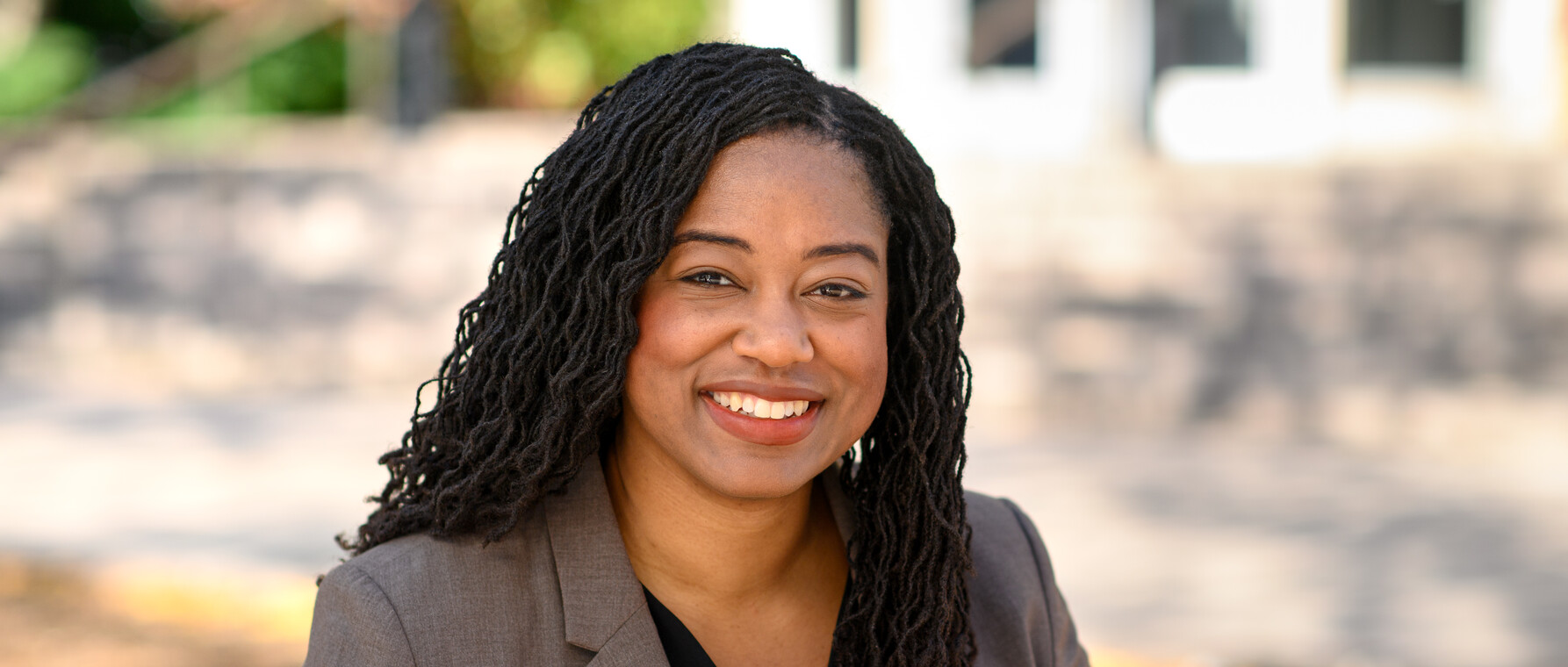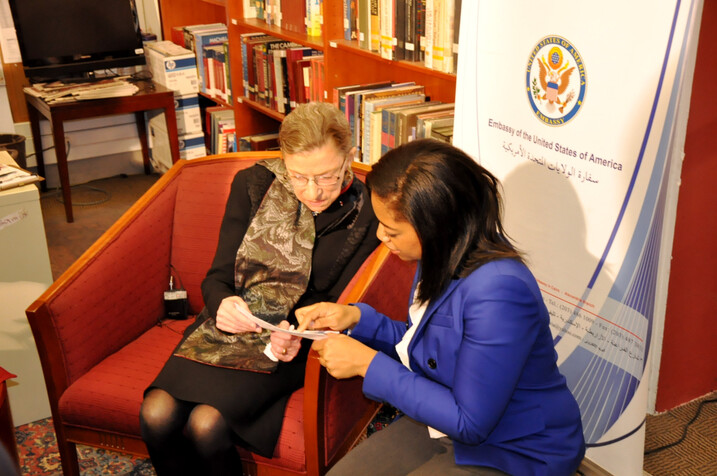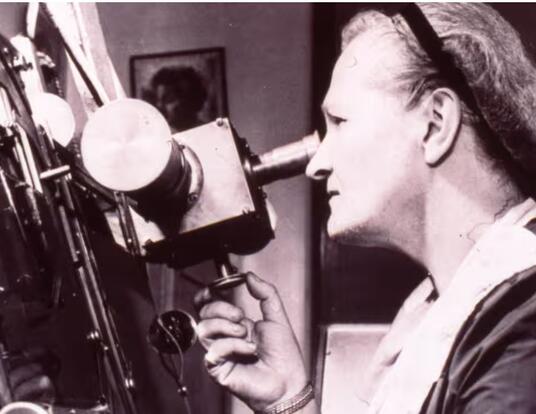Beyond Hearts and Minds
Through public diplomacy, the United States and China seek to influence how others perceive them

Research at Risk: Since World War II, universities have worked with the federal government to create an innovation ecosystem that has yielded life-changing progress. Now much of that work may be halted as funding is withdrawn. Find out more about the threats to medical, engineering, and scientific research, as well as how Harvard is fighting to preserve this work—and the University's core values.
In 2012, Supreme Court Justice Ruth Bader Ginsburg visited Egypt and spoke to young women studying law at Alexandria University. It was the Arab Spring, and with the overthrow of Egypt’s autocratic leader, Hosni Mubarak, and elections for a new president and parliament in the offing, the students hoped to participate in public and professional life in ways that had not been open to them before.
Ginsburg talked about her own experience in the legal profession and academia at a time when both were dominated by men. She spoke about the challenges of going to graduate school and building a career in a society that also expected her to take responsibility for home and family life. The Egyptian women responded. The obstacles that Ginsburg confronted were not so different from the ones they faced, her achievements not so far from their dreams.
The event left a profound impression on Naima Green-Riley, a young foreign service officer recently assigned to Egypt.
“Justice Ginsburg’s visit sticks in my mind as an example of the richness of public diplomacy,” she says. “Here I was in a different country, being inspired by a US leader in my own right, but also seeing how personal contact can bring people together and have implications for how others think about their political future.”

One decade later, Green-Riley studies the conduct and impact of public diplomacy as a PhD candidate at Harvard’s Graduate School of Arts and Sciences. In particular, she explores how the United States and China try to positively influence the way that citizens of other nations see them. Green-Riley finds that public diplomacy works, but often not in the ways its designers intended. Nevertheless, public engagement like Justice Ginsburg’s talks in Egypt delivers important benefits to diplomats, the citizens whose interests they represent, and the people they are trying to influence in other countries. As tensions rise between the United States and China, Green-Riley fears that the accompanying decline in public diplomacy will increase the risk of conflict between the two great powers.
Building Connections
Green-Riley defines public diplomacy as “international engagement with publics.” Moreover, that engagement needs to be overt. Clandestine efforts by governments, say, to spread disinformation and influence the domestic elections of their rivals do not qualify.
As a scholar, Green-Riley is interested in how public diplomacy affects the ways that individuals think, act, and engage politically. “That’s directly measurable,” she says. “You can give a survey to somebody who has participated in a public program and see if their thinking or the ways that they are interacting with their own locale or the international scene are changing. You can look at the data.”
Green-Riley’s research focuses on several prominent areas of public diplomacy, including international broadcasting and educational programming. Specifically, she explores the impact of Alhurra, a US government-run, Arabic-language television channel, and China’s Confucius Institutes and Classrooms initiatives.
Alhurra is based in Springfield, Virginia, and broadcasts in Arabic to audiences in 22 Middle Eastern countries. Although it has bureaus across the Middle East (as well as Washington, DC), the channel makes it clear that its programming originates in the United States. “The staff at Alhurra told me that it exists to provide information that helps people in the Middle East better understand our country, its culture, and society. The station’s goal is to give citizens of other nations a perspective on the US that comes ‘from the horse's mouth.’”
Alhurra’s programming is mostly news and information. Green-Riley says it does not present the United States as a utopia and covers topics like poverty and the opioid epidemic. The channel’s reach varies widely. In some countries, it’s watched by around a quarter of viewers; in others, less than 5 percent.
Confucius Classrooms are available in countries around the world—including the United States. They are affiliated with larger Confucius Institutes, often set up at universities. Funded by the Chinese government, the program offers Mandarin language instruction and cultural activities like calligraphy, cooking, and Tai Chi.
Green-Riley says that according to Chinese practitioners, the goal of Confucius Classrooms is to promote a clearer, more objective understanding of China. Chinese officials and intellectuals often speak of the “China threat theory”—the idea that there is an unfair bias against China internationally. Confucius Institutes/Classrooms are some of the ways that China attempts to reach foreign audiences directly.
“China has a difficult task in trying to build connections with an outside world in which many countries don't share its values,” Green-Riley explains. “In many countries the way that politics happen, and the way that people understand society is often diametrically opposed to the way that things operate in China. That’s one reason why it has focused on trying to have greater influence in countries that need its economic support.”
[Green-Riley’s] research is an important example of how social science could help to moderate ill-informed public policy discourses.
–Professor Alastair Iain Johnston
Limits and Unexpected Benefits
So, how effective have the United States’ and China’s efforts been? Green-Riley found that Confucius Classrooms did little to improve opinions of China among US students from 2019 to 2020—a time when the global pandemic and the US presidential election generated a lot of negative rhetoric about the country. Students in two high schools Green-Riley studied became less favorably inclined toward China, as did the average American, regardless of whether they were enrolled in Confucius Classrooms or not. However, there were observable differences in how much students in Confucius Classrooms knew about China and how they articulated their understanding of the Asian nation.
“Students who were in Confucius Classrooms developed extremely complex views of China compared to peers who did not take part in the program,” Green-Riley says. “The participants were able to name several things that were both positive and negative about China at the same time. They had a much more complex understanding of the politics and social dynamics in China than their peers.”

Alastair Iain Johnston, Harvard's Governor James Albert Noe and Linda Noe Laine Professor of China in World Affairs, says that Green-Riley’s work is the first rigorous, social scientific research on the effect that China's Confucius Institutes and Classrooms has on attitudes toward China.
“Naima finds that, so far, any panic over the subversive influence of these programs is just that, a panic,” he says. “In fact, she finds that attending Confucius Classrooms leads to less positive attitudes toward China, the exact opposite effect that critics in the US claim. Her research is an important example of how social science could help to moderate ill-informed public policy discourses.” (Green-Riley agrees that her research should assuage concerns about the ideological impact of Confucius Classrooms, but she leaves it to future research to determine whether there might be illiberal institutional—rather than personal—effects of Confucius Institutes.)
In the case of US broadcasting in the Middle East, Green-Riley says that Alhurra struggles to find a wide audience in many countries where there exists a high degree of anti-Americanism. At the same time, the channel does reach its target viewers, who generally respond positively to its programming.
“My survey research showed that certain people, when they encountered American programming through Alhurra, were actually quite pleased with it and wanted more,” Green-Riley says. “A more liberally minded group of Arab citizens were the ones that seemed to be more open to watching. Reaching those people in itself is very difficult to do, so that’s a success for the US.”
Invaluable, if Less Visible
Now an instructor in the Department of Politics and the School of Public and International Affairs at Princeton University—her position will convert to an assistant professorship in the fall of 2023 after her formal graduation from GSAS—Green-Riley says that her research points to both the possibilities and the limits of public diplomacy. There is only so much that programming can do to change political thinking, especially in the short term and especially on topics where participants have strongly held views on an issue. Someone who favors China’s expanding role in their country—or in the world—for instance, isn’t likely to adopt concerns about China trumpeted by the United States just because they enjoy American broadcasts.
Professor of Government Joshua D. Kertzer, who sits on Green-Riley’s dissertation committee, says that her research matters for scholars and policymakers because it provides them with a theoretical framework that helps make sense of public diplomacy’s multiple objectives and rigorous empirical tests to evaluate what works in practice.
“Countries spend enormous sums on public diplomacy efforts like foreign broadcasting and foreign exchanges, out of the assumption that the best way to ensure peace and stability is to engage directly foreign publics,” he says. “The United States alone spends billions of dollars on public diplomacy efforts a year, and politicians in Washington routinely raise the alarm about other countries’ public diplomacy activities—particularly those carried out by China. Yet despite the clear interest the policy community has in public diplomacy, we have relatively little systematic evidence that tells us how and if public diplomacy works. Naima’s work is a big step forward.”
Green-Riley says that, although her work may point to the limits of public diplomacy, it also shows that public diplomacy engagement helps create people-to-people ties between nations—like the ones made by Justice Ginsburg during her visit to Egypt. For that reason, she is concerned about the recent rise in tensions between the United States and China, which has made travel, scholarly exchange, and public programming more difficult for both countries.
Despite the clear interest the policy community has in public diplomacy, we have relatively little systematic evidence that tells us how and if public diplomacy works. Naima’s work is a big step forward.
–Professor Joshua D. Kertzer
“It's harder and harder for US citizens to get an idea of what's really going on in China and vice versa,” she says. “People are becoming more reliant on information that is filtered through the political lens of domestic leaders who have power. Under those conditions, our understanding decreases and we tend to see the ‘other’ in a less humanistic way. Tensions continue to rise and productive engagement becomes more and more difficult.”
The United States and China are a “textbook case” of two very powerful, very different countries working out their coexistence in the world, Green-Riley says. While she remains optimistic about the future, she says the years ahead could be contentious.
“If current trends are any indication, it seems that we're going to have a lot of conflict for a good amount of time moving forward,” she says. “Opportunities for both countries to engage in public diplomacy will be few and far between—and more difficult to implement. The current stance of leaders appears to be: ‘If your country isn’t getting along with mine, there’s not a lot of impetus for either of us to allow the other to publicly engage with our citizens.’ That’s what we can expect in the near future—for better or worse—in US-China relations.”
Photos courtesy of Naima Green-Riley
Get the Latest Updates
Join Our Newsletter
Subscribe to Colloquy Podcast
Simplecast





